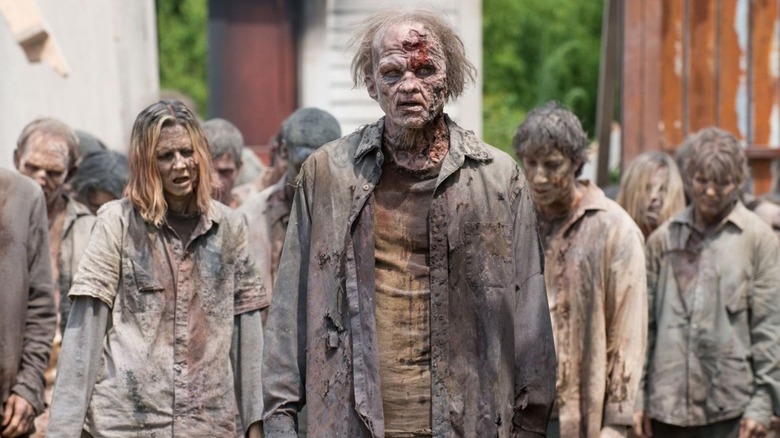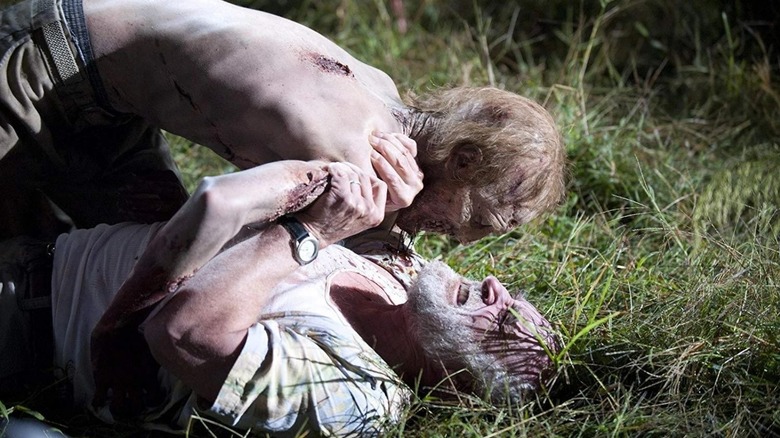When Casting The Walking Dead's Zombies, It's All About The Eyes
The undead in "The Walking Dead" have many things in common. They all look like they've just rolled out of a grave, their language is limited to grunts and gurgles, and they all have uneven, stunted movements. Of course, the gory makeup aids in creating the illusion of deathly pallor, but it's up to the actor to make weird face contortions and enhance the effect.
Post-apocalyptic horror television has turned its main cast into massive stars, but the show's underappreciated heroes are the background actors — the zombies. Or should we say walkers, since "The Walking Dead" survivors refer to the monstrous creatures that inhabit their lands and roam near-soundlessly as "walkers." The show never actually uses the word "zombies," despite popularizing them. The AMC drama's cannibalistic monsters have been terrifying audiences since the show first premiered in 2010 and have dominated pop culture conversation for a good reason.
"The Walking Dead" takes their zombies pretty seriously — the show's brain-eaters aren't created by CGI. They are background actors discovered and trained by the show's creators. Greg Nicotero, the executive producer and special effects and makeup expert on "The Walking Dead," has detailed the show's process while on the lookout to cast their next zombie with AdAge. And when it comes to finding the right walker, it's all about the eyes.
It's All About The Eyes
Anyone can play a slow-moving, glassy-eyed corpse with a bit of training, but when it's for "The Walking Dead," there are certain features its creators are looking out for. Prosthetic makeup expert and zombie movie fan Greg Nicotero keeps specific visual attributes in check when hiring background actors to play zombies. Want to know the one trait that's shared by all of them? They have excellent bone structure and big eyes. "The Walking Dead" is based on the comic book series created by writer Robert Kirkman and artist Tony Moore, and the creators behind the adaptation borrowed inspiration from it. As Nicotero put it:
"There's a visual attribute to it. We always go for people who have really good bone structure. Sometimes they have big eyes. On the show, all the walkers have contact lenses. All their eyes are dead, cloudy, bloodshot and disgusting. The better their eyes read, then the more effective their look is. Often, we'll do custom dentures so it looks like their lips are peeled away, revealing more teeth, which is a visual we took from the graphic novel. Sometimes you'll look at real mummified corpses, and the lips shrivel away, revealing teeth, which is this horrific look. We mimic that."
Nicotero has also directed episodes on the AMC zombie drama and looked back at his work on "What Comes After," the fifth episode of the ninth season. The prosthetics expert was particular with a zombie that killed one of the show's main characters — Dale Horvath (Jeffrey DeMunn). Nicotero paid attention to the minor details, ensuring that the zombie resembled a "horrific doll" after applying makeup.
"I directed the episode in which a walker killed Dale. I was very specific with him. He had really good bone structure and he literally looked like a horrific doll. It was a really neat makeup my guys did. In editing I made sure to cut out any instances where the actor blinked. When people blink, that's an involuntary reflex, so with zombies, I try to take those lifelike performance bits away. You watch it and it's so weird, and you might not realize why."
Casting a zombie can be a tricky task, but Greg Nicotero's precision and attentiveness have undoubtedly contributed to "The Walking Dead" becoming the terrifying viewing experience it is.

